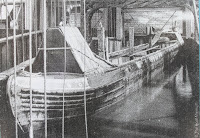Anderton Boat Lift
Easter 2010 - part 5
Easter 2010 - part 5
6th April 2010
The plan was to take the first lift down to the Weaver Navigation, not booking and therefore saving the fee.
Anderton Boat Lift
We were therefore somewhat peturbed to see nb Frankie sliding past us at 8.30am, clearly intent on following the same course of action. I legged it down to the booking office just in time to bag the other 9.30 am slot alongside Frankie. The thing to remember about the lift is that it isn't primarily there for the boats at all - they are merely a necessary extra to bring the spactacle to life for the hoards of visitors that flock to the site. The lift therefore operates to a strict timetable and, a bit like feeding time at the zoo, and the tourists all gather at the appointed hour to witness the miracle of boats being raised and lowered between the Trent and Mersey and the Weaver.
I was rather surprised to discover that this is a thoroughly modern lift dressed in an antique guise, but no less wonderful for that. What we now see is Anderton Lift mark three, retaining its signature legs and profile, but housing three distinct lifting mechanisms.
Mark 1 was built in 1875 and lasted 29 years before corrosion brought the primitive hydraulics to a grinding halt.
1908 restoration
Mark 2 was completed in 1908 and included the iconic cogs and gearwheels which form the contemporary lift's crown. This version lasted a creditable 75 years with the cassions balanced in a cats cradle of cables and counterweights, which now comprise the walls of a maze in the grounds.
Weighty Maze
Mark 2 also suffered corrosion problems, this time to the antique legs which gave up the ghost in 1983. Curiously, I shared Big Lock in Middlewich with an elderly boater whose craft was the very last one to use the old lift before it was mothballed in 1983. The lift creaked and groaned its way to the top, then burned itself out never to work again.
Mark 3 is a nearly new creation, with the cables and weights replaced by a new hydraulic ram system, with two new cassions sitting perched atop two 206 ft pistons which are capable of either lifting a balanced pair or working independently with a full 256 ton load. These pistons are sheathed in some amazingly resistant coating and have been given a design life of an impressive 100 years.
So what purpose does the old framework serve? Well, apart from the aesthetics, which is a big factor for a Scheduled Ancient Monument, it serves as a guide for the cassions and also supports the western end of the substantial aqueduct which connects the canal to the lift structure.
Anderton Boat Lift Aqueduct
Yes Captain, but what's it like to ride? I hear you cry. I think it's fair to say that the spectacle of the Anderton Boat Lift exceeds the experience of riding it. Peering down from the top cassion to the boats below is impressive but the slow creep up and down is something of an anti climax, with plenty of time to exchange greetings with the rising boats as you pass.
This is no ultra modern boat lift like the Falkirk Wheel, but neither is it a refurbished old structure. Instead it is something of a clever hybrid, combining the reliability and safety of a modern lift with the visage of what went before. It's the same trade off that faces the restorers of the Foxton Inclined Plane. It needs to look authentic, even if the historical aspect is only skin deep.
Redundant gearwheels
You would think that riding the Anderton Boat Lift is a deliberate act, but that's not always so. At the time of our visit a boat had rushed onto the last lift down and casually asked the lift keeper if this was the way to Wigan! It appears that they had confused the Anderton Boat Lift with the Barton Swing Aqueduct, which share few similarities apart from a common designer.
This lovely old lift rightly deserves it's continued place as one of the seven wonders of the waterways. Travel on it if you can, but if you can't try and visit.










Thanks for sharing, that looks interesting!
ReplyDelete